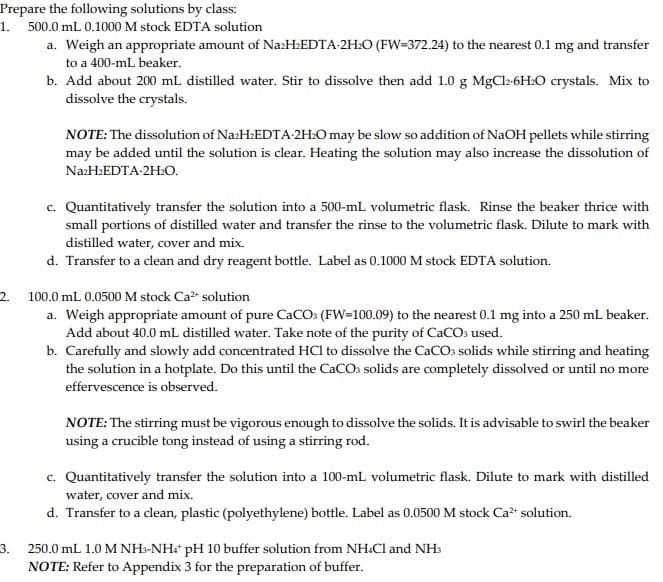Chemistry
10th Edition
ISBN:9781305957404
Author:Steven S. Zumdahl, Susan A. Zumdahl, Donald J. DeCoste
Publisher:Steven S. Zumdahl, Susan A. Zumdahl, Donald J. DeCoste
Chapter4: Types Of Chemical Reactions And Solution Stoichiometry
Section: Chapter Questions
Problem 47E
Related questions
Question
pls compute how to prepare the 3 solutions

Transcribed Image Text:Prepare the following solutions by class:
1. 500.0 mL 0.1000 M stock EDTA solution
a. Weigh an appropriate amount of Na:H:EDTA-2H:O (FW=372.24) to the nearest 0.1 mg and transfer
to a 400-mL beaker.
b. Add about 200 mL distilled water. Stir to dissolve then add 1.0 g MgCl2-6HO crystals. Mix to
dissolve the crystals.
NOTE: The dissolution of NazH:EDTA-2H:O may be slow so addition of NaOH pellets while stirring
may be added until the solution is clear. Heating the solution may also increase the dissolution of
Na:H:EDTA-2H:O.
c. Quantitatively transfer the solution into a 500-mL volumetric flask. Rinse the beaker thrice with
small portions of distilled water and transfer the rinse to the volumetric flask. Dilute to mark with
distilled water, cover and mix.
d. Transfer to a clean and dry reagent bottle. Label as 0.1000 M stock EDTA solution.
2.
100.0 mL 0.0500 M stock Ca" solution
a. Weigh appropriate amount of pure CaCO: (FW=100.09) to the nearest 0.1 mg into a 250 mL beaker.
Add about 40.0 mL distilled water. Take note of the purity of CaCOs used.
b. Carefully and slowly add concentrated HCl to dissolve the CaCOs solids while stirring and heating
the solution in a hotplate. Do this until the CaCOs solids are completely dissolved or until no more
effervescence is observed.
NOTE: The stirring must be vigorous enough to dissolve the solids. It is advisable to swirl the beaker
using a crucible tong instead of using a stirring rod.
c. Quantitatively transfer the solution into a 100-mL volumetric flask. Dilute to mark with distilled
water, cover and mix.
d. Transfer to a clean, plastic (polyethylene) bottle. Label as 0.0500 M stock Ca²* solution.
3.
250.0 mL 1.0 M NH--NH pH 10 buffer solution from NH.Cl and NH3
NOTE: Refer to Appendix 3 for the preparation of buffer.
Expert Solution
This question has been solved!
Explore an expertly crafted, step-by-step solution for a thorough understanding of key concepts.
Step by step
Solved in 6 steps

Knowledge Booster
Learn more about
Need a deep-dive on the concept behind this application? Look no further. Learn more about this topic, chemistry and related others by exploring similar questions and additional content below.Recommended textbooks for you

Chemistry
Chemistry
ISBN:
9781305957404
Author:
Steven S. Zumdahl, Susan A. Zumdahl, Donald J. DeCoste
Publisher:
Cengage Learning

Chemistry: An Atoms First Approach
Chemistry
ISBN:
9781305079243
Author:
Steven S. Zumdahl, Susan A. Zumdahl
Publisher:
Cengage Learning


Chemistry
Chemistry
ISBN:
9781305957404
Author:
Steven S. Zumdahl, Susan A. Zumdahl, Donald J. DeCoste
Publisher:
Cengage Learning

Chemistry: An Atoms First Approach
Chemistry
ISBN:
9781305079243
Author:
Steven S. Zumdahl, Susan A. Zumdahl
Publisher:
Cengage Learning


Chemistry & Chemical Reactivity
Chemistry
ISBN:
9781337399074
Author:
John C. Kotz, Paul M. Treichel, John Townsend, David Treichel
Publisher:
Cengage Learning

Chemistry by OpenStax (2015-05-04)
Chemistry
ISBN:
9781938168390
Author:
Klaus Theopold, Richard H Langley, Paul Flowers, William R. Robinson, Mark Blaser
Publisher:
OpenStax
